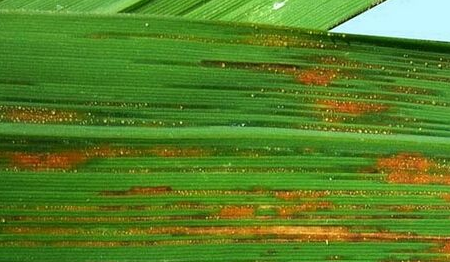Rice bacterial stripe disease, referred to as thin strip disease, is a bacterial disease caused by the genus Bacillus licheniformis and is one of the domestic phytosanitary pests. High temperature and high humidity are conducive to the onset of the disease. At this time, it is caused by heavy rain, hail or flood, which causes a lot of wounds in the leaves, and the disease is very popular. Long-term irrigation of deep water and partial application, delayed application of nitrogen fertilizer is also serious. The incidence of light disease is reduced by about 10%, and that of severely ill fields can be reduced by 40% to 60%.
Characteristics of the damage: Rice bacterial leaf streak mainly invades the leaves, and the disease spots are dark green water-clear and translucent small spots at the beginning, and then gradually expand along the vein direction.
When expanded, it is restricted by veins. The lesions are thin or short dashed, yellow-brown. When the field humidity is high, the surface of the diseased part has honey yellow pus spillage, which is dew-like, dense and dense, and the number is much smaller than that of bacterial blight. After dry knot, it is yellow gum-like small particles, shaped like a dotted line, and is not easy to fall off. When the disease is severe, the streaks merge into irregular yellow-brown to pale white plaques, and the appearance is somewhat similar to bacterial blight, but many transparent thin strips are visible on the light. When the condition is serious, the leaves are curled and the field is yellowish white.

Prevention and treatment methods: The disease is transmitted quickly. Once the disease is difficult to control by chemical control alone, comprehensive prevention and treatment should be adopted. 1 Quarantine: Strictly control the external adjustment of seeds in the ward to prevent the expansion of the ward. 2 Agricultural control: Select disease-resistant varieties, and the degree of disease and loss of different varieties is different. Implement shallow water irrigation and timely drying the fields. Avoid excessive and excessive application of nitrogen fertilizer. Appropriate application of phosphorus and potassium fertilizers to increase plant resistance, prevent rice seedlings from growing up and causing disease. 3 chemical control: After the discovery of the central diseased plant, start spraying 20% ​​leaf cumin (Yeqing double) wettable powder, 100 grams per acre, 50 liters of water. When the effect of leaf sulphate is not obvious, it can be mixed with streptomycin sulfate or agricultural streptomycin 4000 times solution or strong chlorin 2500 times solution at the same time of application of leaf sulphate, which can obviously improve the control effect. For areas with widespread disease, the seeds should be soaked in water for 12 to 24 hours before sowing, and soaked with 300 times of 85% strong chlorine for 12 to 24 hours, then picked up and washed and germinated. Spray the strong chlorin in the three-leaf stage of the seedlings and before the hoeing. At the heading stage, 4% amide copper, 20% chloroform and potassium permanganate were added to the salt spray to prevent and control, and the effect was over 80%.
Sight Glass,Sanitary Welding Sight Glasses,Tube Welding Sight Glasses,Sanitary Sight Glass
Wenzhou Gaoya Light Industry Machinery Co.,ltd. , https://www.hongyafitting.com